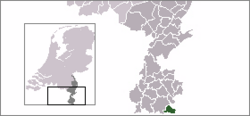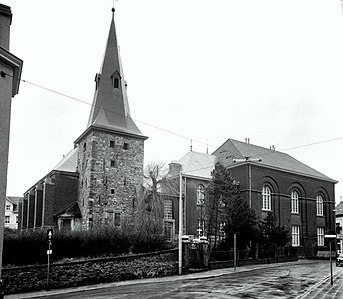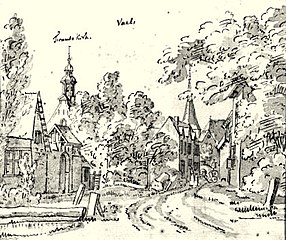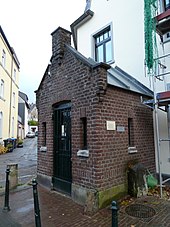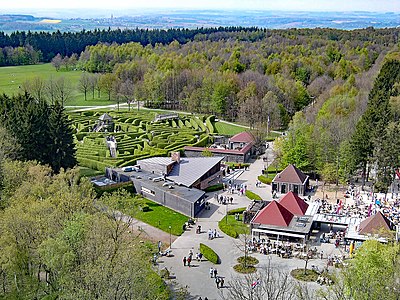Vaals
 flag |
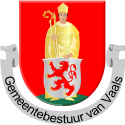 coat of arms |
| province |
|
| mayor | Harry Leunessen ( PvdA ) |
| Seat of the municipality | Vaals |
|
Area - land - water |
23.9 km 2 23.89 km 2 0.01 km 2 |
| CBS code | 0981 |
| Residents | 10,109 (Jan 31, 2019) |
| Population density | 423 inhabitants / km 2 |
| Coordinates | 50 ° 46 ′ N , 6 ° 1 ′ E |
| Important traffic route |
|
| prefix | 043 |
| Postcodes | 6291, 6294-6295 |
| Website | Homepage of Vaals |
Vaals ( [ f̠aːɫs ] ) is a church and a place in this church. This is located in the extreme south-east of the Dutch province of Limburg , about 23 km east of the provincial capital Maastricht and 5.5 km west of the city center of Aachen . Vaals is called “Vols” in dialect, the inhabitants call themselves “Völser”.
Geography and geology
Vaals is located directly on the German border and merges into the Aachen district of Vaalserquartier .
The border community consists of the three main towns Vaals, Lemiers and Vijlen . The settlements Raren and Wolfhaag belong to Vaals, to Lemiers Holset and Mamelis, to Vijlen Camerig, Cottessen, Harles, Melleschet and Rott.
The Vaalserberg , the highest point in the continental Netherlands, is located in the municipality . Since the Caribbean island of Saba officially became a special municipality in the Netherlands in 2010 , the Mount Scenery volcano there is considered the highest point in the Netherlands at 877 m above sea level. On the Vaalserberg, 322.50 m above the NAP , is the triangle of Belgium , Germany and the Netherlands, which was a four-country triangle between 1839 and 1919 . Furthermore, in the area of the municipality of Vaals, on the road to Gemmenich (Belgium), at 275 m, the highest border crossing in the Netherlands can be found.
In terms of nature , Vaals lies in the main unit group Vennvorland (No. 56) and the main unit Vaalser Hügelland (561.3). The current geological formation of Vaals was largely determined in the last Cretaceous period , as it occurs in the south of the Netherlands and in Belgian Limburg and, due to its high proportion of glauconite, consists mainly of green sandstone. In addition, it is a semipermeable aquarium rock layer, which means that the groundwater can only poorly seep into the ground. At the points where this soil stratification is interrupted, springs emerged from which the Vaals brooks were formed, most of which flow over the Senserbach into the Göhl and this in turn into the Maas .
More than two million years ago, the area around Vaals was relatively flat, which is why the Meuse ran a few kilometers further east than it is today along an approximate line between Eijsden, Epen and Vijlen bei Vaals. It was only when the Ardennes and their foothills gradually rose from the Pliocene that Vaals received its current characteristic hilly landscape and the Meuse and its river bed were pushed back westwards.
history
The area around Vaals was settled early on. Burial mounds from the Bandkeramischen culture (5300 to 4900 BC) were found near Vijlen and on the Vaalser Berg as well as the remains of a Roman villa near Lemiers. In Roman times , Vaals was at the crossroads of two Roman roads : on the one hand, the Old Aachen Path from Maastricht to Aachen and the path from the Rolduc Abbey to Alt-Moresnet . In addition, pottery shards from the Carolingian era were recovered in 2016 as part of civil engineering work .
Vaals was first mentioned in 1041 as Vaels (from the Latin vallis = 'valley'). Emperor Heinrich III. According to this document, donated lands in Holset, Lemiers, Vijlen and Mamelis to the St. Adalbert monastery in Aachen , here dialectically called St. Tolbert . The Lehnhof St. Tolbert in Vaals, the "nucleus" of the local development, still exists today and is the seat of the Heemkundekring Sankt-Tolbert Vaals . In addition, the Burtscheid Imperial Abbey was enfeoffed with land in Vijlen and the medieval church there.
From the late Middle Ages to the Napoleonic conquest, Vaals was an area of the glory of Land van Rode , which in turn belonged to the Duchy of Limburg . Most of the estates and estates of Vaals were transferred to various interest-dependent landlords, the so-called Laten , who formed a farm cooperative and were represented by elected lay judges in the Latbank , where the Latrecht was spoken. During this period, the border to the then Aachen Empire was fortified by the Aachener Landgraben , which came down from the Vaalserberg to the Senserbach, then continued over Lemiers to Mamelis and finally up to Orsbach and was marked with eagle stones at various points. At the confluence of the Akenerstraat – Alte Vaalser Straße, a tiny museum (called Kleine Wache , around 1 m²) reminds of the time when the borders were not yet open, unlike today. This border line was manipulated again and again in the area of the old border crossing to around the old Catholic St. Paulus Church in Vaals in order to unlawfully integrate the church on the grounds of the Aachen Empire.
In the early modern period the Duchy of Limburg and also the place Vaals to come Republic of the Seven United Netherlands , and the States-General which are sold as part of the Peace of Westphalia of 1648, which both the Eighty Years 'War and the Thirty Years' War had ended, from the Holy Roman Empire (HRR) were eliminated. This reorganization of the states was finally confirmed in the so-called Party Treaty of 1661 and only then did the border between Vaals and the Aachen Empire run as it still exists today.
Since that time, Vaals has also been an industrial location, especially for the manufacture of cloth and needles. The place benefited above all from the rigid guild law in the neighboring and now “foreign” Free Imperial City of Aachen with its restrictions on freedom of establishment, technology, pricing and staff. These restrictions had led to the fact that copper hackers, needlers and cloth manufacturers in particular from Aachen moved to those places where they could run their trade without these guild requirements. At the same time, it was the time of the first major religious unrest in Aachen , which resulted in massive emigration and expulsion of Aachen citizens with evangelical faith. The finds of gold coins from the years 1454 to 1466 and silver coins from the years 1566 to 1612, which were found in 2016 during excavations at Von Clermontplein , date from this period . The find is so valuable because so far no such gold coins have been found in the whole of South Limburg.
The Aachen textile manufacturer Johann Arnold von Clermont (1728–1795), who had to leave his home in 1761 under pressure from the Counter-Reformation, was influential in the region . He acquired land across the country in and around Vaals and built and founded several textile companies there. His products found buyers all over Europe right up to the Russian tsarist house. In addition, Clermont was the first to significantly deal with the sewerage of the various streams in the village, from which not only industry but also the entire population benefited and a large part of the formerly swampy meadow areas could be cultivated. But other, mostly German entrepreneurial families, such as Binterim, Peltzer, Troistorff and Tyrell, ensured an economic upturn in Vaals.
Vaals finally became officially Dutch in 1815 through the Congress of Vienna , which assigned Aachen to the Prussian government district and Vaals to the Kingdom of the Netherlands. When Belgium declared itself independent in 1830, Vaals became temporarily Belgian from 1830 to 1839 and then again Dutch.
Since 1890 Vaals has had a picture of Saint Lambert of Liège in his coat of arms next to the Limburg lion , who was previously venerated as the patron saint of the Holset settlement.
On May 10, 1940, the German Wehrmacht marched into Vaals. The NSDAP local headquarters moved into the corner building at Prins-Bernhardstraat / Maastrichterlaan, which is now a medical practice . Before that, the local Vaals group of the Dutch National Socialist Movement (NSB) was based there.
religion
Roman Catholic parish
As forerunners of today's St. Paulus-Kerk, churches in Gemmenich and Vaals are mentioned as early as the end of the 11th century in a list of the imperial estates of the Aachen Marienstift . Another source (before 1200) mentions two chapels in connection with the imperial estates of Gemmenich, which are said to be located in Montzen and Vaals. Not until 1266 and again around 1280 is a church mentioned that was attached to an old parish tower.
This Romanesque- style tower on the corner of Kerkstraat and Bergstraat is the oldest surviving building in the municipality of Vaals. In addition to its new function as a church and bell tower, it served for a long time as a watchtower and defense tower and for several periods as a prison. In addition, between 1580 and 1660, Catholic pastors and schoolmasters as well as Protestant preachers had their apartments there. Until 1967, the steeple belonged to both the Catholic Church and the Hervormde Kerk, which was built on the north side in 1672, and is still operated by the Protestant Church after the Catholic Church was demolished in 1967, although it is owned by the Roman Catholic parish.
The Catholic church built on the east side of the tower in the 13th century, which was baptized to the Apostle Paul based on the bell inscription from 1406, initially served the Catholics from 1649 to 1663 together with the newly founded Low German Reformed community as a simultaneous church . After that it was used exclusively as a Protestant church until the inauguration of the new Hervormde Kerk in 1672. Your parish also extended to Vaalserquartier, as there was no Catholic parish there at that time. Nevertheless, the Catholic parish of Vaals and Vaalserquartier could only use their regained church to a limited extent due to the increasing dilapidation and they finally received approval in 1751 to build a new church in the same place. Until 1815, when Vaals officially became Dutch through the Congress of Vienna, St. Paulus belonged to the parish of St. Jakob in Aachen and was then an independent parish. Due to the further strong increase in the number of parishioners, the church had to be significantly rebuilt and expanded in 1833. Eventually this too became too small and in 1892, about 200 m away on the lower Kerkstraat, the current neo-Gothic St. Paulus Church was rebuilt according to plans by the Maastricht architect J. Kaiser. The old church building served as an event space for a long time and was finally torn down in 1967 and the area converted into a parking lot.
From the early years of the 13th century to around 1663, the house in Alte Vaalser Strasse No. 88 in Vaalserquartier served as the Catholic pastor's shop. Subsequently, based on the above-mentioned party contract of 1661, the church council set up the new pastorei in a house on Dutch property directly at the old border crossing Kleine Wache in Akerstraat 2-4, of which only the basic foundations are available today and on which a new house is now was built. In the course of the new construction of today's St. Paulus-Kerk, the old pastorei was given up and finally in 1912/13 a new one was built right next to today's church.
In 1956 Kaplan Peters was commissioned by St. Paulus Church to plan a second parish church in Vaals. The Catholic community bought a piece of land north of the Maastricht Laan and had the St. Jozefkerk built there based on plans by the architect Jan Huysmans. He designed a three-aisled hall church in concrete construction and with a convex-concave corrugated concrete roof. The Dutch artist Charles Eyck was responsible for the glass work. The foundation stone was laid on April 29, 1956 and the church was consecrated on April 28, 1958. On June 19, 2000, due to the sharp decline in the number of parishioners, it was closed, the benches were donated to Cardinal Jānis Pujats in Riga and the bells removed. Today there is a school, library and residential buildings on the square.
Evangelical congregations
As early as 1558, a Reformed community with French liturgical language was founded in Aachen , which mainly copper masters from Wallonia and France joined, who had fled from the troops of the Duke of Alba around 1554 . After the Free Imperial City of Aachen had committed itself to the Catholic faith in the Augsburg Imperial and Religious Peace of 1555, the Reformed worship services were gradually banned there and the preachers of the new denomination were expelled. Many then moved to Burtscheid , Stolberg and Vaals, where religious practice was not restricted to this extent, and held their services there. Not only the French-speaking Reformed people living in Aachen and the surrounding area, but also numerous religiously persecuted people from the Eupen area, called Geusen here , regularly attended the services in Vaals, which initially took place in private apartments. The “Geusenweg” in Vaalserquartier still bears witness to this eventful history.
In the States General, in contrast to the HRR, in which the Roman Catholic denomination remained the only predominant religion until the end of the Old Kingdom around 1794, there was extensive tolerance of Protestantism , which was mainly Calvinist . Only then was it officially possible for the French Reformed Congregation to be founded in Vaals in 1649, which had the Waalse Kerk built in Akener Straat in 1667 . This church existed until 1803 and was then bought by the High German Reformed Congregation, which dismantled the building in 1837 and sold it to a baker. The traditionally French Reformed believers met in the basement of the building opposite at Kerkstraat 31 / corner of Akener Straat, today Haus Schatulle (treasure chest) , where they held their services for a longer period of time.
Another Protestant community was founded on March 21, 1649, the High German Reformed Community, which was joined by a particularly large number of Protestant residents from Aachen and Burtscheid. Until 1663 the Reformed and the Catholic community shared their St. Paulus Church as a simultaneous church, which the Reformed then took over temporarily until 1672 at the instigation of the States General. Finally, they received permission to build their own Hervormde Kerk , which was built on the north side of the Catholic bell tower and inaugurated in 1672. The associated pastorei was built in 1716/1717 by the Aachen architect Laurenz Mefferdatis in the immediate vicinity. Since then, the Reformed congregation has been able to hold its services largely undisturbed in the Hervormde Kerk, which is now part of the Maas-Heuvelland parish in the Protestant Church in the Netherlands .
In addition, a Lutheran congregation was founded in the middle of the 17th century on the initiative of Johannes Clermont (1612–1682), which from 1669 was able to hold the first undisturbed services in a room at the Römer restaurant in Vaals. His son Esaias Clermont (1647–1706) acquired the Vaals copper farm on today's von Clermontplein 11 in 1695 and set up a room in this building for services and devotions for the Lutheran congregation of Aachen and Burtscheid in German. His grandson of the same name Esaias (1698–1751), heir and court lord of Neuburg Castle and father of the later aforementioned Cloth Baron von Vaals, Johann Arnold von Clermont, finally had a church for the Lutheran congregation next to his copper mill based on plans by the major engineer Build littig. For this church building, the wing of the previously three-wing copper courtyard to the west of the inner courtyard had to be demolished. Outwardly, this Lutheran church should look as little as possible like a church in order not to provoke the Roman Catholic Church too much in times of religious unrest. De Kopermolen served as a church house until 1955 and was then converted into a cultural center and is currently the seat of the Centrum voor Kunst en Cultuur Vaals .
In addition, there was a small Mennonite community at the beginning of the 17th century , which was also made up of expellees from Aachen and Burtscheid and met in a small house in the village. Around 1740 she set up her own house of worship in a building complex opposite the ancestral home of the Johann Arnold von Clermont family, which was later built in 1761, which they only operated until around 1780. Around this time, Clermont took over this house and set up a weaving and dyeing works there, which is why the Vaalser call the house the Verves House (dye works) today.
politics
The politics of Vaals are directed by an elected mayor, who in this capacity is both the chairman of the current 13-member municipal council made up of elected party members and of the College van burgemeester en wethouders made up of three councilors. The seat of the municipal administration has been the Clermont house since its renovation in the years 1975 to 1979 , the former parent house of the cloth manufacturer Johann Arnold von Clermont and later Ignaz Tyrell.
Vaals is the place in the Netherlands with the highest proportion of German citizens (26%). In the local elections on March 7, 2006, Georg Götz, a German citizen, was elected to a local council for the first time in the Netherlands - first for the local party “Burgerbelang” (citizens' interests) , which he left in 2007, and again in the local elections on March 3 2010 for his new own party "Betaalbaar & Duurzaam Vaals" (B&DV; for example: Affordable & Sustainable Vaals ). For “Vrij & Onafhankelijk” (V&O; Free & Independent ), Babette Lemmer has since taken another German place on the Vaals municipal council. Since the last local election in 2018, Vaals has been formed by a coalition of CDA (3 seats), V&O (3 seats) and Lokaal! (2 seats) managed.
Distribution of seats in the municipal council
The municipal council has been formed as follows since 1982:
| Political party | Seats | |||||||||
|---|---|---|---|---|---|---|---|---|---|---|
| 1982 | 1986 | 1990 | 1994 | 1998 | 2002 | 2006 | 2010 | 2014 | 2018 | |
| CDA | 2 | 2 | 5 | 5 | 4th | 5 | 5 | 3 | 3 | 3 |
| Fractie Scheffers - Vrij en Onafhankelijk | - | 2 | 1 | 1 | 2 | 3 | 2 | 3 | 4th | 3 |
| Nuj Lies Vroemen | - | - | - | - | - | - | - | - | - | 2 |
| Lokaal! a | - | - | - | - | - | - | - | - | 3 | 2 |
| PvdA | - | 4th | 4th | 4th | 6th | 4th | 3 | 3 | 2 | 2 |
| Het Alternatief | - | - | - | - | - | - | - | - | - | 1 |
| Betaalbaar & Duurzaam Vaals | - | - | - | - | - | - | - | 2 | 1 | - |
| Pro Vaals | - | - | - | - | - | - | - | 1 | - | - |
| Burger issue | - | - | - | - | 1 | 2 | 4th | 1 | - | - |
| VVD | 2 | 2 | 3 | 2 | 1 | 1 | 1 | - | - | - |
| D66 | - | - | 0 | 1 | 1 | - | - | - | - | - |
| Perspectief '85 | - | 1 | 2 | 2 | - | - | - | - | - | - |
| Europese Socialist Unie | - | 0 | 0 | 0 | - | - | - | - | - | - |
| Vaalser Vreemdelingpartij | - | - | 0 | - | - | - | - | - | - | - |
| Democratic Objectieve Eenheid b | - | 2 | - | - | - | - | - | - | - | - |
| Werknemersfractie Vaals | 3 | 1 | - | - | - | - | - | - | - | - |
| Democratic concerns community | 3 | 1 | - | - | - | - | - | - | - | - |
| Objectieve burger issues | 3 | - | - | - | - | - | - | - | - | - |
| Vooruitstrevende Partij Vijlen | 1 | - | - | - | - | - | - | - | - | - |
| Lijst Heinen | 1 | - | - | - | - | - | - | - | - | - |
| total | 15th | 15th | 15th | 15th | 15th | 15th | 15th | 13 | 13 | 13 |
- Remarks
Current college of mayors and councilors
The following people belong to the college :
- mayor
- Harry Leunessen (PvdA; in office: January 20, 2020)
- Alderman
- Jean Paul Kompier (Lokaal!)
- Paul de Graauw (Fractie Scheffers - Vrij en Onafhankelijk)
- John Coenen (CDA)
- Community Secretary
- John Bertram
Former Mayor Vaals
- 1814–1835: Carl Theodor Arnold von Clermont (son of Johann Arnold von Clermont)
- 1836–18 ??: Friedrich Frans Joseph Maria Anton von Pelser-Berensberg
- 18 ?? - 18 ??: Friedrich Heinrich von Clermont (son of Carl Theodor Arnold von Clermont)
- 1843–1866: Andries Joseph van Reij
- 1866–1903: Leonard Frans Hubert Carl Ruland
- 1903–1904: Willem Lodewijk van Reij (son of Andris Joseph van Reij)
- 1904–1907: Carl Clemens Sträter
- 1907–1917: Frederic Victor Quadekker
- 1917–1941: Hubertus Joseph Rhoen
- 1941–1944: Frans Jacobus Wilhelmus Souren
- 1944–1944: Wilhelm Bernhard van de Werff; ( NSB )
- 1944–1950: Hubertus Joseph Rhoen
- 1950–1951: Cees Becht; ( CIP )
- 1951-1976: Jozef FJ Maenen; (CIP)
- 1977-1984: Emile van Leent; (KVP), ( CDA )
- 1985–1991: Rien Damen; (PvdA)
- 1991-1992: Louw Hoogland; (PvdA)
- 1992-1995: John van Dijk; (PvdA)
- 1996-2005: Monique Quint-Maagdenberg; (PvdA)
- 2005-2006: Hans Lurvink; (CDA)
- 2006-2020: Reg van Loo; (independent)
- since 2020: Harry Leunessen; (PvdA)
Economy and Infrastructure
After 1840, industrial development stagnated due to increasing competition and political isolation from the German and Belgian hinterland. Instead, Vaals became a place of recreation and relaxation for the people of Aachen; one spoke of the "Vaals paradise". For this purpose, Vaals received a spa house with an adjoining concert hall in 1898 on behalf of the Aachen brewery Dittmar & Sauerländer . In addition, the neighboring old house Binterim, which was built by Joseph Moretti in 1790 and served as the home of the mayor Carl von Clermont and the cloth manufacturer Theodor Binterim, was converted into a spa hotel at the end of the 19th century.
This economic upswing was primarily due to the construction of a new straight and wide thoroughfare, which is now Maastricht Laan , which was completed around 1825 . Before that, the through traffic on the old Roman route had been tormented, which, coming from Aachen, branched off from today's Vaalserstraße in Vaalserquartier and when Alte Vaalser Straße passed the former border Kleine Wache . The then through road then continued over the narrow and unpaved village streets with the current names Akener Straat, Bergstraat, Bloemendalstraat, Vaalser Hagweg, Heuvelweg to Oude Aker Weg in the direction of Vijlen and further in the direction of Maastricht.
Due to the new Maastricht Laan, there was a horse-drawn tram to Aachen from 1889, which in 1895 became the first electric tram in the Netherlands. In 1925, the Limburgsche Tramweg Maatschappij (LTM) built a steam tram line from Vaals via Wijlre to Maastricht , which increased German border tourism during the Weimar Republic . There was also an option to change to the Aachen tram . After the Second World War , the Aachen tram only went to the border in Vaalserquartier; it was discontinued in 1974 as the last tram in the Aachen area. Today the following lines of ASEAG , Veolia Transport Nederland and the Belgian Transport en Commun (TEC) operate cross-border from Vaals:
- Line 25 (ASEAG): from Vaals via Aachen bus station and Brand to Stolberg
- Line 30 (ASEAG): from Vaals via Burtscheid , Tivoli and Westbahnhof to Aachen University Hospital
- Line 33 (ASEAG): from Vaals via the University Hospital and Aachen Bus Station to Fuchserde
- Line 35 (ASEAG): from Vaals via Aachen bus station, Brand and Kornelimünster to Breinig
- Line 43 (Veolia Transport): from Vaals via Simpelveld and Kerkrade to Heerlen
- Line 55 (ASEAG): from Vaals border via Aachen bus station, Brand and Kornelimünster to Lichtenbusch
- Line 61 (Veolia Transport): from Vaals via Vijlen and Mechelen to Gulpen
- Line 143 (Veolia Transport): from Vaals via Nijswiller to Heerlen
- Line 149 (Veolia Transport): from Vaals to the three-country point
- Line 350 (Arriva): Coming from Aachen Elisenbrunnen and Aachen Hauptbahnhof via Vaals and Gulpen-Wittem to Maastricht
- Line 396 (TEC): from Vaals via Gemmenich , Kelmis , Hergenrath , Walhorn , Kettenis to Eupen
- Line N4 (ASEAG ( night traffic )): from Vaals via Aachen bus station to Elisenbrunnen
The economy began to flourish again in 1948. Because of the cheaper prices in comparison to Germany, the people of Aachen prefer to use Vaals again for shopping, the so-called butter trips . At the end of the 1960s, buying groceries (and thus smuggling them to Germany) was no longer particularly worthwhile, as the European Economic Community (EEC) founded in 1957 gradually adjusted food prices. However, coffee, tea and especially cigarettes were much cheaper for many years than in Germany, and that is why this "cross-border trade" flourished extremely well - and with it smuggling. Gasoline and diesel fuels were so cheap that it was not only worthwhile for the population of Aachen, but also far into the Cologne area, to drive across the border to refuel and at the same time to do some big shopping. On Saturdays, a backlog of vehicles could often be observed from the border crossing one to two kilometers in the direction of Aachen. It was thanks to these decades-long circumstances that the municipality of Vaals experienced a remarkable economic boom through such trade. It was not until the abolition of border controls on March 26, 1995 with the newly created Schengen area and the introduction of the common currency, the euro , that prices for these goods rose to about the same level as in Germany.
In addition, Vaals developed as an interesting place of immigration, especially for young families, who were able to buy land and houses cheaply in and around Vaals according to Dutch standards and at the same time were valued more cheaply by the double taxation agreement . This trend peaked in the years 1950 to 1970 and then slowed down sharply after housing prices in the Netherlands had risen sharply and tax advantages were largely abolished by legislative amendments.
From an economic point of view, tourism is the main source of income for Vaals, since the neighboring coal industry and then the textile industry was lost in the 1960s. Most of the residents commute to work in the larger neighboring cities of Heerlen, Kerkrade and Maastricht as well as Aachen and the surrounding area. One sixth of the population was classified as poor according to the latest national poverty monitor in the Netherlands. In order to make the center more attractive again, a master plan was drawn up in 2008 by the Heerlen architect Jo Coenen , which is primarily intended to strengthen tourism, but also to offer a cheap alternative to rented apartments for the student body and for young families from Aachen due to the housing shortage there .
tourism
In terms of tourism, both the town of Vaals with numerous buildings from the 17th to the 19th century and the entire municipality of Vaals have a lot to offer. First, there are the government-designated protected local areas in the center of Vaals and villages Raren, Cottessen, Mamelis and Lemiers with its numerous under monument protection , the Old square courtyards, palaces and mansions, former factories, historic churches and monasteries, mills and half-timbered houses. Furthermore, the municipality of Vaals benefits from its location in a wooded hilly landscape, which includes the Vaalserberg with its connection to the Aachen forest and the old smuggler routes, as well as the Vijlener forest. Various tourist attractions such as two observation towers and a natural labyrinth on the Vaalserberg and a children's farm in the Vijlener Forest as well as old barrows from the Bronze Age and several forest restaurants in both forest areas are the visitor magnets of the region. An extensive and extensive network of hiking and biking trails ensures that the flow of visitors is well distributed. In particular, the well-developed yet low-traffic side streets around Vaals, some of which are connected to the Mergelland route, are an Eldorado for racing cyclists and are often included as part of the Amstel Gold Race .
In addition, Vaals has a go- kart track , several golf courses and a large holiday park belonging to the Landal Green Parks chain. For those interested in art, the place offers the Vaals art route every year , during which numerous works of art can be viewed as part of a walk past various historical buildings and squares. In addition, the Vaals Museum is located outside the village , which was set up in the chapel of the former Camillian monastery of “Haus De Esch”. More than 200 figures of saints as well as images of Mary, death notes and rosaries are exhibited there, the majority of which were donated by churches, monasteries and private individuals.
In 2005, the Gulp- und Göhltal near Vaals was awarded five stars by the Stichting Natuur en Milieu ( Foundation for Nature and Environment ) as the most beautiful landscape in the Netherlands and in 2011 the place was recognized for its urban and scenic quality, infrastructure policy and the Hospitality accepted into the Cittàslow organization .
Personalities
Sons and daughters:
- Marie Charlotte Neviandt , née Binterim (1826–1889), wife of the theologian Heinrich Neviandt and translator
- August Brandt (1866–1917), theologian
- Willi Hoss (1929–2003), German trade unionist and politician
People related to the city:
- Johann Joseph Couven (1701–1763), German architect and builder of the Baroque , designed the Baroque high altar (attributed) and the pulpit (secured) for the Lutheran church De Kopermolen
- Jacob Engelbert Teschemacher (1711–1782), German organ builder, built the organ in the Hervormde Kerk in 1772
- Johann Arnold von Clermont (1728–1795), German cloth manufacturer, builder of Blumenthal Castle and many other structures
- Otto Intze (1843–1904), German civil engineer, professor of hydraulic engineering , building construction and building materials studies at the Technical University of Aachen, buried in the Protestant cemetery in the Tentstraat
- Dominikus Böhm (1880–1955), German architect and church builder, designed the St. Benedict Abbey in Mamelis , which was built from 1921 to 1923
- Theodore von Kármán (1881–1963), Hungarian-German-American engineer; Pioneer of modern aerodynamics and aerospace research; Professorship and head of the Institute for Aerodynamics at the Technical University of Aachen; lived in Vaals from 1913 to 1926
- Leo Ketelaars (1913–1992), Dutch violinist, opera singer, singing teacher and composer, lived and died in Vaals
- Reiner Dick (1940–1974), German professor of business administration , died in Vaals in 1974
- Herbert Bardenheuer (1949–2007), German painter, draftsman and photographer
- Bruce Darnell (* 1957), American choreographer and model, lives in Vaals
- Willihaben (* 1958), German writer, lives in Vaals
Others
A Martian crater with a diameter of 10.6 km was named after Vaals.
literature
- Adolph Vaessen: The story of Vaals . ( Online text )
- Andreas Lechtape : Abdij S. Benedictusberg, Vaals . 2nd Edition. German edition. (= Art guide; No. 1886). Schnell and Steiner, Regensburg 1999, ISBN 3-7954-5604-5 .
- JF van Agt: South Limburg. Vaals, Wittem en Slenaken (= De Nederlandse Monuments van Geschiedenis en Kunst. ). Staatsuitgeverij, 's-Gravenhage 1983, ISBN 90-12-04096-5 ( digitized version ).
Web links
- Official website (German)
Individual evidence
- ↑ a b Benoeming Burgemeester Vaals. In: rijksoverheid.nl. Rijksoverheid, January 6, 2020, accessed January 23, 2020 (Dutch).
- ↑ Bevolkingsontwikkeling; regio per maand . In: StatLine . Centraal Bureau voor de Statistiek (Dutch)
- ↑ Classification according to the manual of the natural structure of Germany
- ↑ Martina Stöhr: Archaeologists make interesting discoveries during construction work on the Queen Julianaplein in Vaals . In: Aachener Nachrichten of June 23, 2016
- ↑ Martina Stöhr: Archaeologists make interesting discoveries during construction work on the Queen Julianaplein in Vaals . In: Aachener Nachrichten of June 23, 2016
- ↑ Gemeente Vaals eigenaar van 't Vereinshoes , section Invloed Tweede Wereldoorlog on vaals.nl/actueel from 9 January 2015
- ↑ detailed description of the former Jozef-Kerk on kerkgebauwen-in-limburg
- ↑ Result of the local elections: 2014 2018 , accessed on August 30, 2018 (Dutch)
- ↑ Allocation of seats in the municipal council: 1982–2002 2006 2010 2014 2018 , accessed on August 30, 2018 (Dutch)
- ↑ Samenstelling college van B&W Gemeente Vaals, accessed on August 30, 2018 (Dutch)
- ↑ Vaals scoort hoog op armoedeladder and Waar zijn al poor van Vaals? , in: Dagblad De Limburger from 4th and 5th December 2013, edition Heuvelland
- ↑ Heiner Hautermans: Vaals obliges well-known architects , in Aachener Nachrichten of November 12, 2008
- ↑ Information Art Route Vaals 2016 ( Memento from August 12, 2016 in the Internet Archive )
- ^ Website Museum Vaals
- ↑ Press release on Vaals from September 30, 2005
- ↑ Press release of Cittaslow of 25 June 2011 ( Memento of 31 July 2016 Internet Archive )
